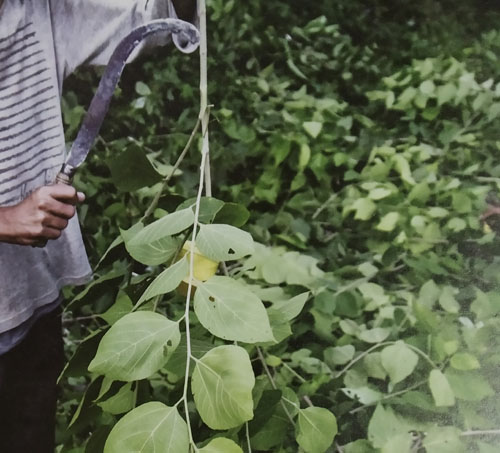Bhimal is the local name of a deciduous tree species called Grewia optiva. Other vernacular names are bheku, bhekua, and bhimu. The bast fibres of the tree are rough and uneven. These fibres are used to make ropes and good quality paper. The branches of the tree have been used as torches and firewood since earlier times. The thicker branches are used to make handles for small agricultural tools while the thinner branches are woven into baskets. The bark of the bhimal tree produces mucilage which is used to make hair shampoo.
The pruning of the tree and de-leafing of the branches is done in winters. In the month of April, the dried branches are laid out in the sun. The branches are then bunched together and weighed down using large stones in running water. This process is called retting. Retting is done for thirty to forty days depending upon the thickness of the branches and the temperature of the water. The flowing water seeps into the branches and breaks down the cells thus breaking the outer layer. This results in the rotting of these branches through bacterial action. The bacteria rot the pectin or the gum that holds the fibres together. Over-retting of the branches can weaken the fibres and produce poor quality ropes.
After retting, the branches are thrashed against boulders to loosen the bark and the phloem from the wood. The fibres are washed, dried in the sun and then separated. The dried fibres are called sel. The sel are hand-twisted to make ropes and strings in the rainy season so that the moisture content in the atmosphere makes the twisting of fibres easy. The jyor/thick rope is made of three thinner ropes plied together. Its function is to tie animals, yoke bullocks to the plough, and fasten firewood for carrying. Seenkhand jao are thin strings used for tying vegetable bags.
Sometimes, instead of undergoing degumming initially, the fibres are directly used as strips to tie or wrap bundles and strengthen fences. The bhimal rope is wrapped around a coil of grass to make a potholder. To create textile quality yarn out of bhimal, the fibres have to be softened, carded, and spun. This has not yet been possible as the sel is too dry and weak to be spun into yarn.
Gallery
YOUR VIEWS
PRACTITIONERS: INDIA
Access 70,000+ practitioners in 2500+ crafts across India.
BIBLIOGRAPHY
10,000+ listings on arts, crafts, design, heritage, culture etc.
GLOSSARY
Rich and often unfamiliar vocabulary of crafts and textiles.
SHOP at India InCH
Needs to be written.






